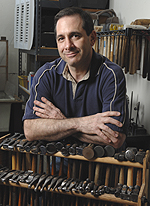How to Identify a Solid Silver Object – By Jeffrey Herman, hermansilver.com
September 16th, 2011 by adminCopyright Jeffrey Herman, hermansilver.com
Normally, if an object is solid silver it will be indicated on the piece. Examples are: Sterling, 925, 925/1000, 900, Coin, Standard, 9584 (English Britannia), 800 (Germany), 84 (Russia), etc.). Most American-made objects are marked on the bottoms of holloware and on the reverse on flatware. Foreign-made objects can be marked most anywhere, and are sometimes accompanied by additional marks applied in the country’s assay office which tests the quality of the precious metal during its manufacture. Rarely will you find a piece made of solid silver that isn’t stamped. If an object isn’t stamped, a non-invasive identification method is judging by tarnish color. Silverplate will exhibit a blue-purple hue, where solid silver will exhibit grey-black. If you cannot determine if an object is solid silver, consult a silversmith or jeweler who may use an acid test.
 Jeffrey Herman started Herman Silver Restoration & Conservation in 1984, and has built a national reputation of quality craftsmanship and sensitivity towards the finishing of every piece. Herman has repaired & reconstructed everything from historically important tankards, tea services, and tureens to disposal-damaged flatware. And yes, he will also polish a single spoon or fork. He considers himself an environmentalist, using the safest, non-toxic, most organic products whenever possible.
Jeffrey Herman started Herman Silver Restoration & Conservation in 1984, and has built a national reputation of quality craftsmanship and sensitivity towards the finishing of every piece. Herman has repaired & reconstructed everything from historically important tankards, tea services, and tureens to disposal-damaged flatware. And yes, he will also polish a single spoon or fork. He considers himself an environmentalist, using the safest, non-toxic, most organic products whenever possible.
Herman Silver Restoration & Conservation
PO Box 786
West Warwick, RI 02893
800/339-0417, 401/461-6840
Fax: 401/461-6841
E-mail: jeff@hermansilver.com
Web: http://www.hermansilver.com
